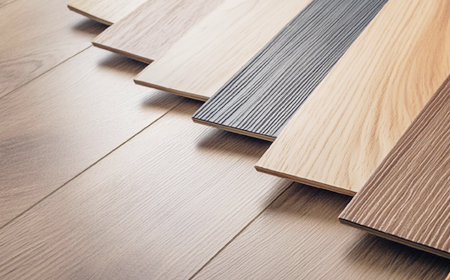- Shortcut menu
- Main menu shortcuts
- Skip to content
PRODUCT INTRODUCTION
- PENOL RESIN
- MELAMINE RESIN
- UREA RESIN
- SPIN/FINISHING OIL/SOFTENING AGENT
- POLYVINEYL ACETATE
- OTHER PRODUCTS
MELAMINE RESIN
Wood / Impregnation / Fabric / Others

01. Wood
01. Characteristics
Because it is excellent in various physical properties including water resistance and easy to handle as a thermoset resin, it is widely used for hardened layer wood and plastering plywood. Not like urea resin, it is excellent in water resistance.
Thanks to its transparant appearance, it can be diversely used for products whose appearance is important.
02. Applicable field
It is used for floor plastering and plywood production. With many years of experience, we can provide the best mixture ratio and solution in accordance with various sites' and customers' requirements. (Hardened layer wood, timber, molding plywood adhesion, plywood adhesion for domestic use, Hi-pack seating plate, floor plate adhesion, and patterned wood)
03. Spec
| Solid content(%) | Viscosity(cps) | PH | Use | |
|---|---|---|---|---|
| M-60N | 53~55 | 60~80 | 8.0~9.0 | Patterned wood adhesion, Low Formaldehyde |
| M-60K | 53~55 | 30~40 | 8.0~9.0 | Ordinary plywood adhesion, Low Formaldehyde |
| M-60S | 50~52 | 35~40 | 8.0~9.0 | Phenolic film faced plywood adhesion |
02. Impregnation
01. Characteristics
As a thermoset resin, it is excellent in oil-absorbing properties and transparent. If it is hardened, it becomes excellent in chemical resistance, thermal resistance, aging resistance, mechanical strength, surface strength, adhesion strength, and water resistance. Its workability is also excellent.
02. Applicable field
As a melamine resin for impregnation, it is used as an impregnation agent for patterned paper glued to various boards.
With many years of experience, we provide the best solution in quantity to be used, mixture ratio, additives, and working conditions in order to meet the customers' needs.
03. Spec
| Solid content(%) | Viscosity(cps) | PH | Use and characteristics | |
|---|---|---|---|---|
| M-70L | 55~57 | 45~55 | 9.2~9.6 | Patterned paper impregnation |
| MJ-50 | 54~56 | 30~40 | Patterned paper impregnation |
03. Fabric
01. Characteristics
As a thermoset resin, it is excellent in chlorine resistance, washing resistance, and water resistance. After processing, there is no change in the color of fabric and no occurrence of Chalk Mark. Even if it is used together with textile assistants such as water repellent, softening agent, and anti-static agent, it works well with them.
02. Applicable field
It is a melamine resin which creates the effects of excellent non-shrink treatment, anti-crease finish, and Hyeongbu process, and wick process to various textiles. It also generates the effects of repellent touch adjustment process to various textiles. It also creates the effects of excellent non-shrink treatment, anti-crease finish, and Hyeongbu process to synthetic fiber or fiber blend.
03. Spec
| Solid content(%) | Viscosity(cps) | PH | Use and characteristics | |
|---|---|---|---|---|
| MR-3 | 69~71 | 220~280 | 8.2~8.6 | General use, non-shrink treatment, anti-crease finish |
| MR-6 | 66~67 | 100~150 | 8.1~8.4 | Durability, non-shrink treatment, anti-crease finish |
| SM-800 | 58~56 | 35~45 | 8.4~8.6 | Flock process, non-woven fabric process |
| M-80S | 74~75 | 800~1000 | 8.2~8.6 | Hyeongbu process, wick process |
04. Others
01. Characteristics
GYC-110 : As an environment-friendly odorless resin, it is used as a melamine resin softener. If the melamine resin is used alone, it is apt to crack by an external impact. So, it is hardly used as an exterial decoration material. If a certain amount of GYC-110 is added to the melamine resin, it can reduce the hardness of the melamine resin and then minimize the occurrence of crack.
MPR-10 : As a phenol melamine copolycondensation resin, it can solve the problems such as "insert crack" or "contamination resistance" which can be found when the melamine resin is used alone.
02. Spec
| Solid content(%) | Viscosity | PH | Use and characteristics | |
|---|---|---|---|---|
| GYC-110 | 46~48 | 400~600 cps | 8.2~8.6 | Melamine resin Softner |
| MPR-10 | 51~53 | 17~19 sec | 8.1~8.4 | phenol melamine copolycondensation resin |

